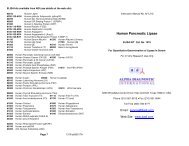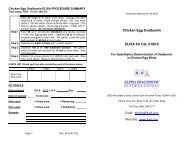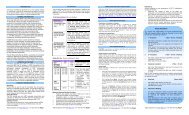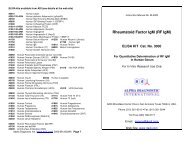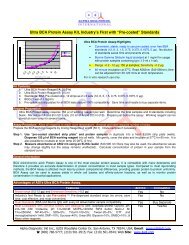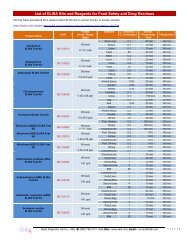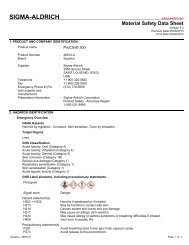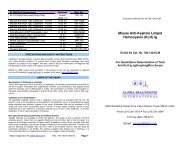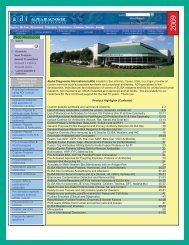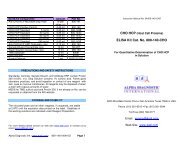Bovine Lactoferrin - Alpha Diagnostic International Inc.
Bovine Lactoferrin - Alpha Diagnostic International Inc.
Bovine Lactoferrin - Alpha Diagnostic International Inc.
Create successful ePaper yourself
Turn your PDF publications into a flip-book with our unique Google optimized e-Paper software.
INTENDED USE<br />
The <strong>Bovine</strong> <strong>Lactoferrin</strong> ELISA Kit is an in vitro immunoassay for the quantification of<br />
lactoferrin in milk and colostrums, or in other appropriately qualified samples from<br />
tissue fluids (e.g., saliva, mucosa), or other solutions.<br />
RESEARCH USE OF THE TEST<br />
<strong>Lactoferrin</strong> is a natural, lactose-free, protein present in milk, which has a high<br />
affinity for iron. <strong>Lactoferrin</strong> is a versatile protein that can prevent the growth of<br />
pathogenic bacteria in the gut, and control cell or tissue damage. <strong>Lactoferrin</strong> also<br />
serves as a bio-regulator of iron and provides supportive functions for the immune<br />
system.<br />
Iron is a key mineral required by many micro-organisms for maintenance and<br />
growth. Regulation of iron by lactoferrin in the digestive tract helps to maintain the<br />
correct balance of beneficial and harmful bacteria. <strong>Lactoferrin</strong> binds free iron and<br />
works with the immune system to achieve homeostasis. <strong>Lactoferrin</strong> delivers bound<br />
iron to beneficial bacteria and healthy cells by way of transferrin and helps maintain<br />
the current iron level by a complex biological process involving ferritin and<br />
transferrin. <strong>Lactoferrin</strong> decreases free, non-absorbed iron that would be otherwise<br />
available to pathogens.<br />
<strong>Lactoferrin</strong> has also been shown to inhibit certain cytokine and interleukin<br />
production, which allows for the reduction of swelling and the increase of circulatory<br />
activity in the vicinity of injury.<br />
PRINCIPLE OF THE TEST<br />
The <strong>Bovine</strong> <strong>Lactoferrin</strong> ELISA kit is based on the binding of bovine lactoferrin in<br />
samples to two antibodies, one immobilized on the microtiter wells, and the other<br />
conjugated to horseradish peroxidase (HRP) enzyme. After a washing step,<br />
chromogenic substrate is added and color is developed by the enzymatic reaction of<br />
HRP on the TMB substrate, which is directly proportional to the amount of lactoferrin<br />
present in the sample. Stopping Solution is added to terminate the reaction, and<br />
absorbance at 450nm is then measured using an ELISA microtiter well reader. The<br />
concentration of lactoferrin in samples and control is calculated from a curve of<br />
standards containing known concentrations of lactoferrin.<br />
STORAGE AND STABILITY<br />
The microtiter well plate and all other reagents, if unopened, are stable at 2-<br />
8 o C until the expiration date printed on the box label. Stabilities of the<br />
working solutions are indicated under Reagent Preparation.<br />
PERFORMANCE CHARACTERISTICS<br />
Specificity<br />
The antibodies used in this kit have been shown by immunoelectrophoresis and<br />
ELISA to react specifically with lactoferrin, and have essentially no reactivity with<br />
any other bovine serum or milk proteins. Human and goat milk showed essentially<br />
no reactivity at a 1:10 dilution.<br />
Normal Range<br />
Assay of lactoferrin in ten (10) bovine milk samples ranged from 27 to 165 ug/ml;<br />
1% nonfat dry milk measured 13ug/ml. Each laboratory should determine expected<br />
values of its own testing population.<br />
Precision<br />
Samples containing low, medium and high concentrations of lactoferrin were<br />
assayed multiple times in the same assay (n=10) to provide within-assay precision,<br />
and as duplicates in multiple assays (n=5) to obtain between-assay reproducibility.<br />
Coefficient of variations were calculated for the concentrations using a point-topoint<br />
curve-fitting program.<br />
<strong>Lactoferrin</strong> concentrations were measured with very good within-assay (3.4 to 5.3<br />
%CV) and between-assay (3.4 to 5.3 %CV) reproducibility.<br />
<strong>Lactoferrin</strong> Intra-assay Inter-assay<br />
Sample<br />
ng/ml<br />
%CV<br />
%CV<br />
Low <strong>Lactoferrin</strong> 13.9 4.5 5.3<br />
Medium <strong>Lactoferrin</strong> 44.9 3.8 4.2<br />
High <strong>Lactoferrin</strong> 95.0 4.3 3.4<br />
Linearity of Dilution<br />
Two (2) milk samples and one (1) nonfat dried milk sample were diluted to 2 levels<br />
for testing, and concordance of the assay values were compared. The mean<br />
recovery ranged from 93 to 96%, demonstrating linear dilution and equivalent<br />
quantification across the standard range.<br />
Sample<br />
Dilution<br />
Milk Sample A 1:500<br />
1:2000<br />
Milk Sample B 1:500<br />
1:2000<br />
Nonfat Dry Milk 1:150<br />
1:1200<br />
Continued on Page 7.<br />
Assay Value<br />
ng/ml<br />
98.4<br />
22.7<br />
47.3<br />
13.6<br />
80.0<br />
11.5<br />
Milk Value<br />
mg/ml<br />
49.2<br />
45.4<br />
23.7<br />
27.2<br />
12.0<br />
13.8<br />
Concordance<br />
96 %<br />
93 %<br />
93 %<br />
<strong>Alpha</strong> <strong>Diagnostic</strong> Intl (www.4adi.com) Rev. 8090/110211G Page 1<br />
<strong>Alpha</strong> <strong>Diagnostic</strong> Intl (www.4adi.com) Rev. 8090/110211G Page 6



